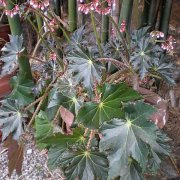Care of the rhizomatous plant Begonia heracleifolia or Star begonia |
|
The genus Begonia, family Begoniaceae, comprises 1,500 species and 10,000 cultivars of plants native to subtropical and tropical regions of Asia, America and Africa. Some species are: Begonia grandis, Begonia elatior, Begonia corallina, Begonia boliviensis, Begonia semperflorens, Begonia rex, Begonia x tuberhybrida, Begonia nelumbiifolia, Begonia heracleifolia. Common name: Star begonia; Hogweed-leaf Begonia (Begonia heracleifolia 'Nigricans') . This species is native to Mexico. They are herbaceous tropical plants with succulent and hairy stems that reach 50 cm (1.64 feet). The leaves have long petioles, 6-7 serrated lobes and very marked veins; They are dark green on the upper surface and reddish on the underside. The flowers are light pink or white. Star begonia is used to form groups or as isolated specimens and to cover understory in gardens with a tropical or subtropical climate; in colder climates they are grown in pots as a houseplant, patio and terrace. Begonia heracleifolia needs a light exposure but avoiding direct sun (leaves can burn). It's a tropical plant that do not resist frost. The soil must contain abundant organic matter and drain very well so it should contain peat and sand. Always water with lime-free water (the best is rain) when the soil has dried; they do not tolerate drought. It is important that the ambient humidity is high but you do not have to spray the plant but place the pot on a plate with moistened pebbles. Fertilize with mineral fertilizer every 3 weeks during spring and summer. Prune withered leaves and flowers. Begonia heracleifolia is attacked by mealybugs, aphids and mites if it is very hot and the humidity is low. Hogweed-leaf Begonia propagates easily by division or by leaf cuttings. |
Images of the rhizomatous plant Begonia heracleifolia or Star begonia |
Find plants
Begonia heracleifolia or Star begonia | Care and Growing
© 2025 FavThemes





